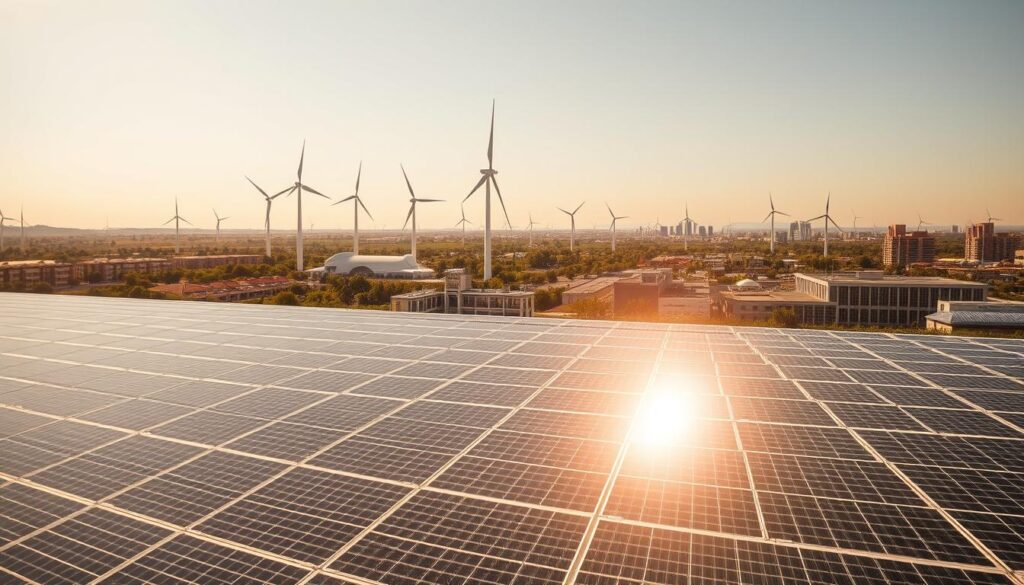The world is shifting toward clean energy, and this transition offers exciting opportunities. Companies focusing on solar and wind power are leading the charge, making renewable energy a key player in the global market.
For example, NextEra Energy boasts a market cap of $148 billion, showcasing the sector’s growth. Brookfield Renewable offers a 4.34% dividend yield, making it a solid choice for income-focused investors. Meanwhile, First Solar has secured 64GW in contracted sales through 2030, highlighting the industry’s potential.
With trillions needed annually for the global energy transition, this sector is both socially responsible and financially rewarding. Whether you’re looking for growth or income, stocks in this space are worth exploring.
Why Invest in Renewable Energy Stocks?
The clean energy sector is reshaping the global economy. Companies focusing on solar energy and wind energy are leading this transformation. This shift offers exciting opportunities for those looking to align their portfolios with the future.
The Growth Potential of Renewable Energy
Renewables made up 99% of new US generation capacity in Q1 2025. Solar installations grew 11% year-over-year, adding 7GW of capacity. Wind power saw a 40% increase, with 2GW added in the same period.
Brookfield Renewable has achieved 11% annual FFO growth since 2016. NextEra Energy’s EPS has grown 9% annually since 2004. These numbers highlight the sector’s profitability and long-term potential.
Climate Change and Social Responsibility
Investing in clean energy stocks allows you to contribute to a sustainable future. California’s NEM 3.0 policy, for example, drives 75% battery attachment rates. This shows how policy and innovation work hand in hand.
Constellation Energy’s $26.6B acquisition of Calpine expands its clean assets. Such moves demonstrate the commitment of companies to a greener world.
Government Support and Incentives
The US aims for renewables to reach 40% of generation within 10 years. Federal tax credits offer 30% savings for residential solar through 2032. However, the ITC phaseout timeline means credits drop from 100% in 2025 to 0% by 2028.
Potential elimination of solar lease tax credits post-2025 is a consideration. Staying informed about these changes is crucial for maximizing returns.
Understanding the Renewable Energy Market
The renewable energy market is evolving rapidly, driven by innovation and demand. As traditional fuels like natural gas continue to play a role, sustainable solutions are gaining traction. This shift is reshaping the market and creating new opportunities for growth.

Key Drivers of the Renewable Energy Sector
Natural gas remains a reliable source, providing 35% of US power in Q1 2025. However, its baseload reliability contrasts with the intermittency of solar and wind. Companies like First Solar are leading with thin-film solar panels, dominating utility-scale projects.
Battery storage is another critical driver, mitigating intermittency issues. Residential installations rose 17% year-over-year in Q4 2024, showcasing its growing importance. This technology ensures a steady supply of electricity, even when the sun isn’t shining or the wind isn’t blowing.
Market Trends and Future Projections
Morningstar values First Solar at $168 FVE, reflecting its strong position in the market. Brookfield Renewable, with an “Exemplary” capital allocation rating, trades at 0.95 P/FVE. These companies highlight the sector’s potential for long-term growth.
Clearway Energy is projected to achieve 5-8% annual CAFD growth post-2027. Meanwhile, rooftop solar shows rebound potential in markets like Florida and Texas. Despite supply chain risks in solar manufacturing, the future looks bright for clean energy.
How to Invest in Renewable Energy Stocks
The transition to sustainable solutions is reshaping investment opportunities. Companies focusing on clean energy are not just driving innovation but also offering promising financial returns. Whether you’re new to this space or looking to expand, understanding the right approach is key.
Researching Clean Energy Companies
Start by evaluating the financial health of companies in this sector. For instance, First Solar holds $1.3B-$2B in net cash despite expansion costs, showcasing its stability. Brookfield Renewable targets 12-15% returns through mergers and organic growth, making it a strong contender.
Morningstar’s 3-star rating for both First Solar and Brookfield highlights their balanced performance. Compare strategies—First Solar focuses on manufacturing, while Brookfield leans on acquisitions. This data helps you make informed decisions.
Diversifying Your Portfolio
Diversification is crucial in any portfolio. Mix utilities like NextEra Energy, producers like Brookfield, and tech-focused firms like First Solar. This approach reduces risk and maximizes potential returns.
Consider dollar-cost averaging to navigate sector volatility. ETFs like ICLN and TAN offer broad exposure to clean energy markets. Avoid overexposure to single technologies or regions to maintain balance.
“Brookfield Renewable’s 20-year dividend growth track record is a testament to its reliability.”
By blending different funds and strategies, you can build a resilient and rewarding portfolio.
Top Renewable Energy Stocks for 2025
The future of clean power is here, and these companies are leading the charge. From solar to wind, these firms are driving innovation and delivering strong returns. Here’s a closer look at the top performers in the market.

NextEra Energy (NYSE:NEE)
With a $148B market cap, NextEra Energy is a giant in the clean energy space. Its Real Zero plan aims for carbon neutrality by 2045, leveraging green hydrogen. The company also offers a 3.09% dividend yield with 10% annual growth, making it a reliable choice for income-focused investors.
Brookfield Renewable (NYSE:BEPC)
Brookfield Renewable boasts a 50% hydro portfolio and is expanding into offshore wind. With a $6B market cap and a 4.34% yield, it targets 5-9% dividend growth. Its diversified assets and strong track record make it a standout in the sector.
Clearway Energy (NYSE:CWEN)
Clearway Energy combines natural gas with renewable assets, ensuring steady power supply. Its 6.06% yield and projected 20% CAFD growth through 2027 highlight its potential. This balanced approach makes it a solid addition to any portfolio.
First Solar (NASDAQ:FSLR)
First Solar focuses on thin-film solar panels, dominating utility-scale projects. With $22B in market cap and 64GW in contracted sales, it’s a leader in the solar space. Its US and India focus, coupled with trade protections, positions it for long-term success.
Constellation Energy (NASDAQ:CEG)
Constellation Energy’s nuclear fleet provides 24/7 clean power, serving 20M customers. With 90% carbon-free generation, it’s a pioneer in sustainable solutions. A recent 1.72% price jump on acquisition news further underscores its growth potential.
These stocks represent the best of the clean energy sector. Whether you’re looking for growth, income, or a mix of both, these companies offer compelling opportunities for 2025 and beyond.
Evaluating Renewable Energy Stocks
Understanding the right metrics is essential for making informed decisions in the clean energy sector. By focusing on key factors, you can assess the value and potential of various businesses in this space.
Key Metrics to Consider
When analyzing companies, start with their financial health. For example, NextEra Energy has achieved a 9% EPS CAGR since 2004, showcasing consistent growth. Brookfield Renewable’s 6% dividend CAGR since 2001 highlights its reliability for income-focused funds.
Look at contracted cash flows, such as Brookfield’s 93% PPA coverage. Compare valuations like First Solar’s 0.93 P/FVE ratio against the sector average. These data points provide a clear picture of a company’s stability and potential.
Assessing Company Performance and Growth Potential
Evaluate growth pipelines, such as NextEra’s 55GW renewable backlog. Debt ratios are also critical—Clearway Energy’s 4.5x net debt/EBITDA is a key indicator of its financial health. Policy risks, like the 45X manufacturing credit impact on First Solar, should also be considered.
Review ESG scores to gauge sustainability efforts. Constellation Energy’s nuclear safety record, for instance, reflects its commitment to clean power. Track records, like Brookfield’s 20+ years of distribution growth, offer insights into long-term performance.
By focusing on these metrics, you can identify companies that align with your investment goals. This way, you build a portfolio that balances value and growth while minimizing cost and risk.
Risks and Challenges in Renewable Energy Investing
Navigating the clean energy sector comes with its own set of challenges. While the potential for growth is significant, understanding the risks is crucial for making informed decisions. From market volatility to environmental factors, there are several obstacles to consider.
Market Volatility and Regulatory Changes
Market fluctuations can impact the sector significantly. For example, the potential elimination of the 25D residential solar credit could reduce incentives for homeowners. Similarly, the 48E ITC phaseout might cut subsidies to 0% by 2028, creating uncertainty for investors.
Interest rate sensitivity also plays a role. The 2024 rooftop solar slump highlights how rising rates can slow adoption. Additionally, interconnection queue bottlenecks often delay projects, adding to the complexity.
- Natural gas price changes can affect renewable competitiveness.
- Trade policy risks for imported components add another layer of uncertainty.
Technological and Environmental Risks
Advancements in technology can make older systems obsolete. Panel efficiency races, for instance, could render current models less competitive. Extreme weather events also pose risks to wind and solar infrastructure, potentially disrupting operations.
Renewable Energy Certificate (REC) price volatility in merchant markets is another concern. These certificates, which represent clean energy generation, can fluctuate widely, impacting revenue streams.
“The NEM 3.0 policy caused a 40% decline in California rooftop solar installations, showcasing how regulatory shifts can disrupt the market.”
By understanding these risks, you can better prepare for the challenges ahead. This way, you’ll be equipped to navigate the sector’s complexities while minimizing potential losses.
Building a Sustainable Investment Portfolio
Creating a sustainable investment portfolio requires careful planning and strategic choices. By balancing risk and reward, you can align your funds with long-term goals while maximizing value. This approach ensures your business remains resilient in evolving markets.
Balancing Risk and Reward
Morningstar’s 3-star ratings suggest fair valuations for many clean energy companies. For example, Brookfield Renewable targets 12-15% total returns through growth and mergers. This balance makes it a strong contender for your portfolio.
Consider blending high-yield options like Clearway Energy with growth-focused firms like First Solar. This mix reduces risk while enhancing potential returns. Diversification is key to navigating sector volatility.
Long-Term Investment Strategies
For compounding gains, use DRIPs with companies like NextEra Energy, which offers 10% annual dividend growth. Hedging with utilities such as Constellation Energy during rate hikes can also stabilize your funds.
Rebalance your portfolio quarterly to maintain sector allocation. Brookfield Renewable’s global diversification across North America, South America, Europe, and Asia provides added stability. Holding through 2030 decarbonization milestones ensures long-term success.
“Allocating 5-15% of your portfolio to renewable equities is a smart way to balance risk and reward.”
By following these strategies, you can build a sustainable portfolio that delivers consistent value over the years. This approach not only supports your financial goals but also contributes to a greener future.
Conclusion
The clean energy landscape is brimming with opportunities for forward-thinking investors. The $26.6B CEG/Calpine deal highlights the sector’s confidence and growth potential. Morningstar’s top picks, FSLR and BEP, stand out for their strong performance and innovation.
California’s 75% battery attachment rates showcase the world’s shift toward advanced solutions. With policy uncertainties, dollar-cost averaging can help you navigate volatility. As Professor Parrish advises, deep sector knowledge is key to making informed decisions.
Looking ahead, 2045 net-zero targets will drive growth for years to come. Start your journey with the NEE, BEP, and FSLR trio to align your portfolio with the future of clean energy.


